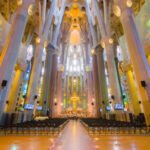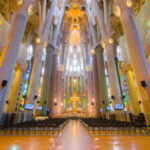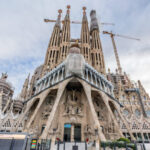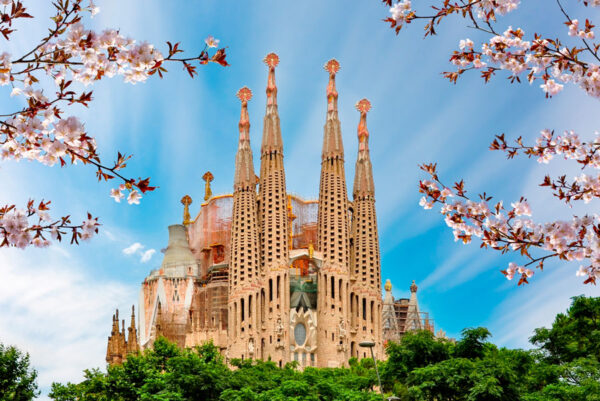
- The Architectural Marvel of the Sagrada Familia: A Deep Dive into Its Significance
- Historical Context of the Sagrada Familia: From Vision to Reality
- Exploring the Unique Features of the Sagrada Familia: A Tour of Its Iconic Design
- The Symbolism Behind the Sagrada Familia: Understanding Gaudí's Artistic Choices
- Visiting the Sagrada Familia: Tips for an Unforgettable Experience
- The Future of the Sagrada Familia: What's Next for This Iconic Landmark
Barcelona is a city where art and architecture blend seamlessly, and no structure embodies this more than the Sagrada Familia. This basilica, designed by the visionary architect Antoni Gaudí, has become a symbol of the city and a testament to the imagination and creativity of its time.
In this article, we delve into **Barcelona's Iconic Landmark: Exploring the Sagrada Familia**, uncovering its rich history, intricate designs, and the ongoing efforts to complete this monumental masterpiece. From its striking facades to the stunning interior, the Sagrada Familia offers a unique glimpse into the genius of Gaudí and the cultural heritage of Barcelona.
The Architectural Marvel of the Sagrada Familia: A Deep Dive into Its Significance
The Sagrada Familia stands as a testament to architectural innovation, blending Gothic and Art Nouveau styles in a way that has captivated visitors for generations. Designed by Antoni Gaudí, its intricate details reflect a deep reverence for nature, with columns resembling trees and facades filled with symbolic imagery. This synthesis of art and engineering not only marks a significant milestone in modern architecture but also invites contemplation of spirituality and the divine.
One of the most remarkable aspects of the Sagrada Familia is its unique construction techniques, which utilize a combination of traditional and modern methods. Gaudí's vision led to the incorporation of hyperbolic and parabolic shapes, allowing for natural light to flood the interior. To illustrate the significance of these elements, consider the following features:
- Light Play: The stained glass windows create a kaleidoscope of colors, enhancing the emotional experience within the basilica.
- Structural Ingenuity: The innovative use of catenary arches provides stability while maintaining aesthetic appeal.
- Symbolism: Each facade tells a story, with the Nativity facade depicting the birth of Christ and the Passion facade illustrating his crucifixion.
As the Sagrada Familia continues its construction, expected to be completed in the coming years, it remains a source of inspiration for architects and artists alike. Its ongoing evolution not only reflects advancements in technology but also honors Gaudí's original vision, making it a living monument to creativity and dedication. This architectural marvel is a profound reminder of the cultural and spiritual values embedded in Barcelona's identity.
Historical Context of the Sagrada Familia: From Vision to Reality
The historical context of the Sagrada Familia is deeply rooted in the vision of its creator, Antoni Gaudí, who began working on the project in 1883. Initially intended as a traditional church, the basilica quickly transformed into Gaudí's most ambitious project, reflecting his unique approach to architecture, which harmonizes nature with spiritual expression. This vision was influenced by the rich cultural and religious landscape of Barcelona during the late 19th century, a period marked by significant artistic movements.
Construction of the Sagrada Familia has faced numerous challenges throughout its history, including financial constraints and the Spanish Civil War, which halted progress for several years. Despite these obstacles, the project has continued to evolve, with various architects and artisans contributing to Gaudí's original design. The following points highlight key historical milestones:
- 1882: The first stone is laid, marking the beginning of the construction.
- 1926: Gaudí's death leads to a temporary halt in the project.
- 2010: The basilica is consecrated by Pope Benedict XVI, solidifying its significance as a place of worship.
Today, the Sagrada Familia stands not only as a remarkable architectural feat but also as a symbol of resilience and dedication to artistic vision. The continued efforts to complete the basilica embody the spirit of collaboration and innovation, honoring Gaudí's legacy while adapting to modern techniques. This journey from vision to reality showcases Barcelona's enduring commitment to its cultural heritage and artistic expression.
Exploring the Unique Features of the Sagrada Familia: A Tour of Its Iconic Design
The Sagrada Familia is renowned for its breathtaking architectural features that set it apart from other landmarks. One of the most striking elements is its towers, which symbolize the twelve apostles and reach towards the heavens. Each tower is intricately designed, with unique decorative motifs that reflect the individual character of the apostle it represents. Visitors are often captivated by the following aspects:
- Height: The tallest tower is intended to reach 172.5 meters, making it the tallest church building in the world.
- Colorful Mosaic Work: Each tower is adorned with vibrant mosaics, illustrating the beauty of nature and spirituality.
- Symbolic Importance: The towers represent a connection between heaven and earth, embodying Gaudí's vision of divine architecture.
Inside the Sagrada Familia, the design continues to amaze, with columns resembling trees that create a forest-like atmosphere. This innovative approach allows for a unique distribution of light and space, enhancing the spiritual ambiance within the basilica. The interior is characterized by:
- Natural Light: The clever placement of stained glass windows casts a colorful glow, changing throughout the day.
- Organic Shapes: Gaudí’s use of natural forms contributes to the feeling of being in a living environment, inviting visitors to reflect on their connection to nature.
- Spiritual Symbolism: Elements of the design hold deep religious significance, inviting worship and contemplation.
Visitors to the Sagrada Familia often remark on the emotional impact of the interior space. The combination of light, color, and form creates an atmosphere that transcends mere architectural appreciation, inviting personal reflection and spiritual exploration. This unique experience is a testament to Gaudí's genius and his deep understanding of how architecture can evoke feelings of wonder and reverence.
The Symbolism Behind the Sagrada Familia: Understanding Gaudí's Artistic Choices
The Sagrada Familia is not just an architectural masterpiece; it is a symbol of faith and spirituality intricately woven into its design. Antoni Gaudí infused the basilica with profound religious meaning, using architectural elements to convey biblical stories and teachings. The facades serve as visual narratives, highlighting key events in the life of Christ, encouraging visitors to engage with the sacred history that shapes the space.
Gaudí's artistic choices reflect his deep connection to nature and his belief in the divine. The natural forms found throughout the Sagrada Familia echo the organic beauty of the world around us. For instance, the columns are designed to resemble trees, symbolizing growth and life. This design choice not only enhances the aesthetic experience but also invites contemplation on humanity's relationship with the divine creation.
Additionally, the use of light plays a crucial role in the symbolism of the Sagrada Familia. As sunlight filters through the vibrant stained glass windows, it transforms the interior into a dynamic tapestry of color, representing the presence of the divine. This interplay between light and space fosters a sense of tranquility and reflection, encouraging visitors to contemplate their spirituality in a uniquely inspiring environment.
In summary, the symbolism behind the Sagrada Familia is a testament to Gaudí's vision of merging art, architecture, and spirituality. Each element, from the grand facades to the intricate details within, tells a story that resonates with the essence of Barcelona's cultural identity. As construction continues, this landmark remains a living symbol of human creativity and the quest for divine connection.
Visiting the Sagrada Familia: Tips for an Unforgettable Experience
When planning your visit to the Sagrada Familia, it's essential to book your tickets online in advance. This not only saves you time by avoiding long queues but also ensures that you secure your desired time slot, especially during peak tourist seasons. Additionally, consider purchasing an audio guide or joining a guided tour to deepen your understanding of Gaudí's remarkable vision and the basilica's intricate details.
Arrive early in the morning or later in the afternoon to enjoy a quieter experience within the basilica. During these times, the light streaming through the stained glass windows creates a breathtaking display of colors, enhancing the spiritual atmosphere. Timing your visit can greatly influence your overall experience, allowing you to soak in the beauty without the crowds.
Don't forget to take a moment to appreciate the surrounding gardens and facades before entering. The exterior of the Sagrada Familia is just as captivating as the interior, with each facade telling a different story. Bring your camera to capture the stunning details, including the unique sculptures and architectural elements that reflect Gaudí's artistic genius.
Lastly, consider visiting the Sagrada Familia on a day when there are fewer tourists in Barcelona, which can often be during weekdays. This will not only enhance your experience but also provide a more intimate connection with this iconic landmark. Remember, the Sagrada Familia is more than just a tourist attraction; it is a place of worship and reflection, inviting all who enter to experience its profound beauty.
The Future of the Sagrada Familia: What's Next for This Iconic Landmark
As the Sagrada Familia approaches its anticipated completion in the coming years, the future of this iconic landmark promises to be as innovative as its past. With ongoing construction, architects are committed to preserving Antoni Gaudí's original vision while integrating modern techniques. This dual approach ensures that the basilica will not only stand as a historical monument but also as a beacon of contemporary architectural practice.
Looking ahead, the completion of the Sagrada Familia will include several significant features that will enhance its spiritual and cultural significance. Key elements to be realized in the final stages of construction include:
- The Glory Facade: This will be the final facade to be completed, representing the glory of Jesus.
- Additional Towers: The remaining towers will be added, with the central tower symbolizing Jesus Christ reaching the planned height of 172.5 meters.
- Enhanced Visitor Experience: Plans for improved visitor facilities will ensure a more enriching experience for those who come to admire Gaudí's masterpiece.
Furthermore, the Sagrada Familia is set to become a center for cultural activities and educational programs. By offering workshops, exhibitions, and guided tours, the basilica aims to deepen the connection between visitors and the architectural marvel. This initiative highlights the importance of ongoing education in preserving the cultural heritage of Barcelona, ensuring that Gaudí's work continues to inspire future generations.
Ultimately, the future of the Sagrada Familia is not just about finishing a building; it is about honoring a vision that transcends time. As this architectural wonder nears completion, it stands as a symbol of creativity, resilience, and the enduring spirit of Barcelona, inviting both reflection and celebration of its rich cultural tapestry.
 Exploring the Depths of Sagrada Familia Barcelona: Unveiling its Magnificent Interior | 94
Exploring the Depths of Sagrada Familia Barcelona: Unveiling its Magnificent Interior | 94 Exploring the Stunning Interior of Barcelona's Sagrada Familia Church
Exploring the Stunning Interior of Barcelona's Sagrada Familia Church Exploring the Wonders Inside Sagrada Família: Barcelona's Architectural Marvel
Exploring the Wonders Inside Sagrada Família: Barcelona's Architectural Marvel The Magnificent Completion of Sagrada Familia in Barcelona
The Magnificent Completion of Sagrada Familia in BarcelonaIf you want to know other articles similar to Barcelona's Iconic Landmark: Exploring the Sagrada Familia you can visit the category WHERE YOU CAN GO.
Deja una respuesta










Read more!